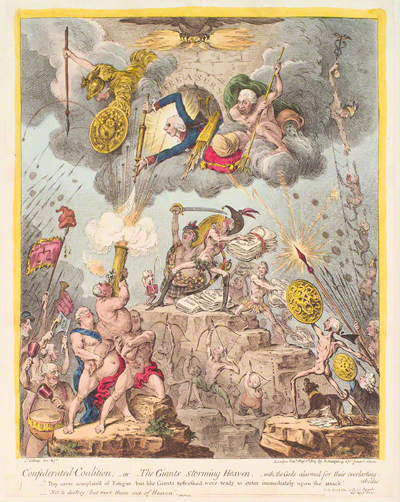Confederated Coalition...
Confederated Coalition, or The Giants Storming Heaven [1804] is one of a number prints in which Gillray provides a fresh perspective on contemporary events by placing them in a classical framework and portraying his highly caricatured figures as if they were part of a history painting. The intent (and effect) is not to ennoble them, however, as a serious history painting would, but rather to make them appear comically absurd.
The story of the Giants' war against the Olympian Gods is mentioned in a number of classical sources, including Hesiod, Pindar, and Ovid, but images of the Gigantomachy, as it was called, would also have been available to Gillray in numerous Greek vases and sculptures at the British Museum. The use of the story by Gillray was no doubt suggested by the remark of Lord Eldon when he said that the ministry welcomed the challenges of the opposition, and felt "like giants refreshed...ready to enter immediately upon the attack." In Gillray's print, however, the opposition is cast in the role of Giants.

The Giants Storming Heaven [1804]
© National Portrait Gallery, London
The struggle we see in Gillray's print, then, is between the Addington ministry supported by the King (the Gods) and a loose and an opportunistic coalition of opposition enemies intent on toppling the ministry (Giants). The "Gods" include the King (represented by Jove's Eagle), Secretary of State for Foreign Affairs, Hawkesbury (Minerva), Prime Minister and First Lord of the Treasury, Addington (Apollo), First Lord of the Admiralty, St. Vincent (Neptune),and Treasurer of the Navy, Tierney (Mercury). Arrayed against the Gods in a brilliant pyramidal design are five identifiable groups with different political agendas but one common goal—to gain power.
The situation in 1804 was this: the Treaty of Amiens negotiated by Addington and Hawkesbury in 1802 had provided a much needed respite from the war between England and France. But it was becoming increasingly clear that Napoleon had simply bought time with the treaty to rebuild his forces. Addington's current policy was to wait and see while building up the volunteer ground forces to repel a potential invasion. But his plans were so poorly conceived and implemented that it only further diminished the general confidence in his ministry. Believing that renewed conflict with France was inevitable and delay would only strengthen Napoleon's hands, Pitt and others strongly criticized the ministry's preparations and argued for an immediate declaration of war.
At the center of the print, then, we have Pitt and his followers leading the charge. These include Dundas, Canning, George Rose, Charles Long, and half-heartedly, William Wilberforce. Pitt, the consummate orator, is armed as he always was, with "Knock-Down Arguments." against the administration. The Scotsman and long-time Pitt ally, Dundas, wields an Andrew-Ferrara broadsword, then accounted the best of its kind. The witty Canning, who hated Addington and had been working for some time with Rose and Long to bring Pitt back as Prime Minister, is armed with "Killing Detections" of ministerial incompetence. His Indian garb is probably a reference to his support for the rights of West Indians and native Americans. The religious Wilberforce carrying the Duty of Man was a long time friend of Pitt and wished him back in office, but was hoping for a ministry that still included Addington.
To the left of Pitt's followers, both visually and politically, is a motley group of Foxites, including Fox (with blunderbuss),Grenville and Buckingham (literally supporting Fox), Norfolk (with kettle drum and wine bottles, Carlisle (with a meat cleaver), and Sir Francis Burdett with the revolutionary bonnet rouge on a spear. Fox opposed war with France, but along with many others had completely lost confidence in the Addington ministry. His choice seemed to be between an inevitable war led by a bungling administation or one led by Pitt. Though he distrusted Pitt, he hoped for a new broad-based ministry where he would able to use his influence to establish a more advantageous and lasting peace. But even within the Foxites, there were varieties of opinion which Gillray subtly indicates.
To the right of Pitt with shields featuring a Medusa head is a group including William Windham, French Laurence, 2nd Earl Spencer, and William Cobbett (as a kind of attack dog through Cobbett's Political Register). Windham, Laurence, Spencer and Cobbett had all been violently opposed to the Treaty of Amiens. Cobbett routinely and derisively referred to Addington as "The Doctor" (after the profession of Addington's father's), so it is no surprise that Gillray shows him relieving himself upon a paper labeled as such. Laurence was, among other things, a Regius Professor at Oxford, so he is shown in academic robes.
Below Pitt's followers and armed with bows are others who supported Pitt in this instance, but who would not otherwise be included as followers. They include Stanhope, Taylor, Grey, and Derby.
In the background, apart from the fighting, Gillray shows one of the Gods, Mercury (Tierney) holding a bag of money and letting down a rope ladder (of preferment?) which some half-human, half-monkey creatures are busily climbing. Among them are Sheridan, Erskine, and Tyrwhitt Jones--all with reputations as opportunists.
Sources and Reading
- Commentary from the British Museum on Confederated Coalition...
- Draper Hill, Mr. Gillray The Caricaturist, 1965, Pl. 100
- "Henry Addington, 1st Viscount Sidmouth," Wikipedia
- "William Pitt the Younger," Wikipedia
- Thomas Wright and R.H. Evans, Historical and Descriptive Account of the Caricatures of James Gillray #290
Comments & Corrections
NOTE: Comments and/or corrections are always appreciated. To make that easier, I have included a form below that you can use. I promise never to share any of the info provided without your express permission.